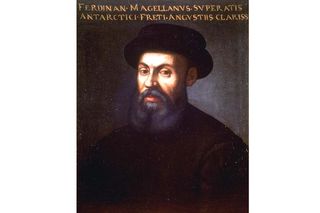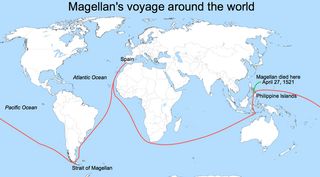Ferdinand Magellan: Facts & Biography

Ferdinand Magellan was a Portuguese explorer who led the first expedition to circumnavigate the globe. Like many of his contemporaries, Magellan set out to discover a Western sea route to the Spice Islands in Indonesia. Magellan ended up proving, instead, that the world was indeed round and bigger than anyone had previously imagined.
Early life
Ferdinand Magellan was born about 1480 to a noble family in Portugal. As a boy, he served the queen of Portugal as a page, and studied cartography and navigation tenaciously.
In his mid-20s, Magellan joined the Portuguese fleet — a job that took him to East Africa, where he fought Egyptian ships in the Battle of Diu; Malacca (Malaysia), where he participated in the conquest of their port; and Morocco, where a wound resulted in a limp he would suffer for the rest of his life. While in Morocco, Magellan was accused of trading illegally with the Moors. Despite his repeated denial of the allegations, Magellan lost his post and future offers of Portuguese employment.
In 1517, Magellan moved to Seville, Spain, where he met a well-connected Portuguese transplant, Diogo Barbosa, married his daughter, Beatriz, and had a son. The Barbosas secured Magellan a meeting with the Spanish court to discuss Magellan’s idea for a voyage. Inspired by the voyages of Christopher Columbus, Vasco Núñez de Balboa and other explorers, Magellan had devised a plan to find a westward-sailing, all-water route to the Spice Islands (also called the Moluccas). Young King Charles I readily approved and financed the expedition.
Journey in the Atlantic
On Aug. 10, 1519, Magellan set sail with 270 men and five ships: the Trinidad (commanded by Magellan), the San Antonio, the Victoria, the Conception, and the Santiago. From Spain, the fleet sailed to Brazil and then headed south, hugging the coast. They were searching for a fabled water passage that would allow them to cross South America without going around Cape Horn.
Going was hard. Magellan searched Rio de la Plata, a Brazilian estuary, fruitlessly for a long time. Many crewmembers were freezing in the bad weather or starving. At Port San Julian, off the coast of Patagonia (which Magellan named), the crew mutinied against Magellan on Easter midnight. He quelled the uprising, killing one captain and leaving another behind. He also sent the Santiago ahead to scout, but it was shipwrecked. Most of the crewmembers were saved, and the fleet spent a winter of harrowing storms in Port San Julian.
Strait of Magellan
When the weather improved, Magellan set sail again. On Oct. 21, 1520, he finally found the passageway that would come to bear his name. The Strait of Magellan is a curvy, narrow channel that separates Tierra del Fuego at the tip of South America from the continental mainland. Sailing through it was treacherous: dangerous to navigate, freezing cold and foggy.
It took the fleet over a month to pass through the 350-mile strait. During that time, the captain of the San Antonio turned his ship around and sailed back to Spain — taking a good deal of the supplies with him.

Pacific Ocean
After 38 days on the strait, the fleet finally emerged at the Pacific Ocean in November 1520. They were the first Europeans to see this ocean. Magellan named it Mar Pacifico because its waters appeared calm in comparison to the difficult strait waters.
Magellan underestimated the size of the ocean, and the ships were unprepared for the journey. Many crewmembers starved while searching for land. Finally in March, the ships landed at Guam. There, they were able to replenish their foot supplies before sailing to the Philippines.
Philippines and Magellan’s death
Upon landing at Cebu, Magellan was overcome with religious zeal and decided to convert the natives to Christianity. Some of the natives agreed to convert, while others did not — and the split caused problems in the population. The Cebuan king became Christian, and sought to fight against a neighboring group, the Mactan, who did not convert. The Cebuans asked Magellan to join them in their fight, and he agreed.
Against the advice of his men, Magellan led the attack, assuming his European weapons would ensure a quick victory. The Mactan people, however, fought fiercely and struck Magellan with a poison arrow. Magellan died from the wound on April 27, 1521.
Return to Spain
After Magellan’s death, Sebastian del Cano took command of the two remaining ships, the Trinidad and the Victoria (the Conception was burned because there were not enough men left to operate it). A former mutineer, del Cano led the ships to the Spice Islands. After securing the spices they had so long ago set out for, the ships set sail for Spain. The Trinidad was attacked by a Portuguese ship and left shipwrecked.
In September 1522 — three years and a month since the journey began — the Victoria docked back in Seville. Only one ship of the original five — and only 18 men of the original 270 — survived the voyage. Among them was Antonio Pigafetta, a scholar who had kept a detailed diary of the expedition.
Magellan’s accomplishments
Though Magellan did not make it around the world, he did lead the first expedition to do so. And though the Strait of Magellan was too dangerous to be used as a regular route, its mapping proved invaluable to the European understanding of the world — as did the European discovery of the Pacific Ocean and the empirical proof that the world was round. [Countdown: 9 Craziest Ocean Voyages]
Sign up for the Live Science daily newsletter now
Get the world’s most fascinating discoveries delivered straight to your inbox.
Jessie Szalay is a contributing writer to FSR Magazine. Prior to writing for Live Science, she was an editor at Living Social. She holds an MFA in nonfiction writing from George Mason University and a bachelor's degree in sociology from Kenyon College.
